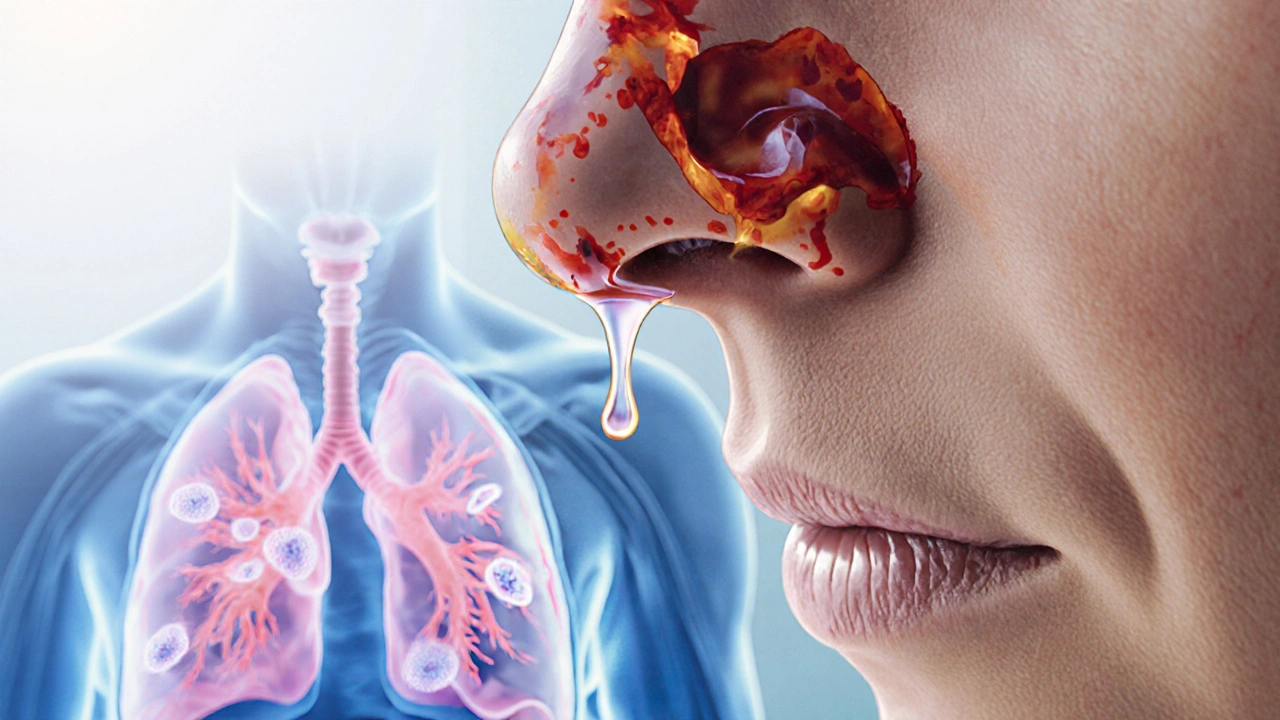When dealing with Sinus Infection, inflammation of the sinus cavities that often brings pain, pressure, and a runny nose. Also known as sinusitis, the condition starts when the lining of the sinuses swells and blocks normal mucus drainage. The blockage creates a warm, moist environment where bacteria or viruses can thrive, leading to nasal congestion, thick yellow or green discharge, and a feeling of fullness around the cheeks and forehead. Because the sinuses sit close to the eyes, teeth, and even the brain, a simple blockage can quickly feel serious. Understanding the basic anatomy—four paired air‑filled chambers lined with mucosa—helps explain why symptoms can range from a mild cold‑like sniffle to intense facial pain.
Most people notice a gradual onset of congestion, a dull ache in the upper teeth, and post‑nasal drip that worsens when they bend over. A viral sinus infection usually improves within 7‑10 days, accompanied by a low‑grade fever, clear or slightly cloudy mucus, and no severe facial tenderness. In contrast, a bacterial sinus infection often lingers past ten days, brings high‑grade fever, thick green or yellow discharge, and sharp pain that intensifies when you lean forward. Other red‑flag signs include swelling around the eyes, double vision, or a sudden loss of smell. Recognizing these patterns early can save you from unnecessary antibiotics while still prompting you to act when the infection refuses to clear.
For mild to moderate cases, the first line of defense includes plenty of fluids, steam inhalation, and saline nasal irrigation. A simple neti pot or squeeze bottle with isotonic saline softens mucus, clears the nasal passages, and reduces pressure without side effects. Adding a humidifier to your bedroom keeps the airway moist, especially in dry winter months, and can lessen the urge to constantly blow your nose. Over‑the‑counter pain relievers such as ibuprofen or acetaminophen reduce inflammation and make you feel more comfortable while your immune system does the heavy lifting.
When the infection appears bacterial or the symptoms are stubborn, targeted medication becomes essential. Antibiotics, prescribed drugs that combat bacterial causes of sinus inflammation are effective only after a doctor confirms bacterial involvement, usually through a physical exam or, in chronic cases, imaging. Common choices include amoxicillin‑clavulanate, doxycycline, or a fluoroquinolone for resistant strains. Pairing antibiotics with Nasal Steroids, sprays that reduce mucosal swelling and improve sinus drainage such as fluticasone, mometasone, or budesonide often shortens recovery time and prevents relapse. Short courses of oral decongestants (pseudoephedrine) can shrink swollen blood vessels, but they should be limited to three days to avoid rebound congestion.
If you notice persistent pressure, repeated infections, or any of the serious warning signs mentioned earlier, it’s time to consult an ENT Specialist, a doctor trained in ear, nose, and throat disorders who can evaluate complex sinus issues. The specialist may order a CT scan to map the sinus cavities and identify blockages, polyps, or anatomical variations like a deviated septum. Based on the findings, treatment can range from a longer course of oral steroids to in‑office procedures such as balloon sinuplasty, where a tiny balloon is inflated to widen the sinus opening, or even endoscopic sinus surgery for severe, recurring disease.
Chronic sinus infection—lasting more than twelve weeks—often has an allergic component. Allergic Rhinitis, an immune response to airborne allergens that inflames nasal tissue fuels ongoing mucus production and makes the sinuses more prone to infection. Identifying triggers—pollen, dust mites, pet dander, or mold—through skin testing or serum IgE panels allows you to target the root cause with antihistamines, leukotriene modifiers, or immunotherapy (allergy shots). In addition, biofilm‑forming bacteria can shield themselves from antibiotics, so a combination of prolonged culture‑directed antibiotics and nasal saline irrigations may be required. Lifestyle changes such as quitting smoking, avoiding vaping, reducing alcohol intake, and maintaining good indoor air quality dramatically lower the odds of chronic flare‑ups.
Prevention is a daily habit. Stay well‑hydrated, use a saline spray twice daily during allergy season, and keep your home free of dust and mold. A simple daily rinse can clear out pollen before it settles, while a humidifier set at 40‑50% humidity prevents the nasal lining from drying out. If you’re prone to infections, consider a short course of a low‑dose nasal steroid during high‑risk periods, but always discuss it with a healthcare provider first. These proactive steps not only reduce the frequency of sinus infections but also improve overall respiratory comfort.
Below you’ll discover a hand‑picked collection of articles that dive deeper into each of these areas—how to choose the right over‑the‑counter decongestant, what to expect from a telehealth antibiotic prescription, and detailed guides on managing chronic sinusitis with allergy testing and surgery options. Whether you’re after quick relief tips or a thorough plan for long‑term sinus health, the resources ahead have you covered.

Learn how sinus infections can lead to pneumonia, spot overlapping symptoms, and discover prevention and treatment tips to protect your respiratory health.